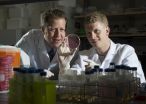Loss of cellular energy leads to neuronal dysfunction in neurodegenerative disease model
Scientists developed new tests to accurately measure brain's energy supply, which is essential for understanding how impairments in the system cause neurodegeneration
2015-09-14
(Press-News.org) A new study from the Gladstone Institutes shows for the first time that impairments in mitochondria--the brain's cellular power plants--can deplete cellular energy levels and cause neuronal dysfunction in a model of neurodegenerative disease.
A link between mitochondria, energy failure, and neurodegeneration has long been hypothesized. However, no previous studies were able to comprehensively investigate the connection because sufficiently sensitive tests, or assays, were not available to measure ATP (the energy unit of the cell that is generated by mitochondria) in individual neurons.
In the current study, which was chosen as the Paper of the Week in the Journal of Biological Chemistry, the scientists created novel assays to more accurately measure the brain's energy production. Using a model of Leigh's disease, a genetically inherited neurodegenerative disorder that affects mitochondria, the researchers tested energy levels in neurons using the new assays. They found that the genetic mutation associated with Leigh's disease compromised ATP levels, and this reduction of ATP was enough to cause significant cellular dysfunction.
"It was always assumed that defects in mitochondria would result in a depletion of energy levels, which would be toxic to neurons," says first author Divya Pathak, PhD, a postdoctoral fellow in the Gladstone Institute of Neurological Disease. "But no one had been able to prove this because the necessary assays were not available. Now that we've demonstrated the link between impaired mitochondria, a loss of ATP, and neuronal dysfunction, the next step is to see if this connection holds true in conditions like Parkinson's disease and Alzheimer's disease."
Applying their new assay in healthy neurons, the researchers also determined the energy threshold needed to support synaptic vesicle cycling--the process by which brain cells release neurotransmitters to communicate with each other. The scientists blocked glycolysis, another way that cells make ATP, so that the cells had to rely solely on their mitochondria for energy. This allowed the researchers to more accurately assess the contribution of mitochondrial ATP to different steps in the cycle, and how this process goes awry when mitochondria malfunction.
From this exploration, the scientists revealed that bringing the vesicles back up into the cell after they have released their neurotransmitters is the most energy-demanding process. Indeed, in the model of Leigh's disease, the cells did not have enough ATP to complete this step.
The researchers also compared energy levels in boutons--the docks from which neurotransmitters are shipped--with and without mitochondria. Remarkably, there was no difference in energy levels between the two, and both types of boutons had sufficient ATP to support synaptic vesicle cycling. From this, the scientists concluded that under normal conditions, ATP diffuses rapidly from boutons with mitochondria to those without, so that even those boutons lacking mitochondria have sufficient energy to function under normal conditions. They note it will be important to determine if boutons lacking mitochondria will still be able to function properly in diseases that disrupt the distribution of mitochondria.
Senior author Ken Nakamura, MD, PhD, an assistant investigator at the Gladstone Institute of Neurological Disease, says that conducting this research in both healthy and diseased cells is essential for interpreting the findings. "We really need to understand the basics of cell biology in a normal setting in order to comprehend changes in disease," he explains. "It's worth taking the time to study these underlying biological processes so that we can identify the best therapeutic targets for neurodegenerative disorders."
INFORMATION:
Other investigators on the study include Lauren Shields, Bryce Mendelsohn, Dominik Haddad, Wei Lin, and Hwajin Kim from the Gladstone Institutes; Akos Gerencser and Martin Brand from the Buck Institute for Research on Aging; and Robert Edwards from the University of California San Francisco.
The study was supported by grants from the National Institutes of Health, the Burroughs Wellcome Fund, the National Science Foundation, the Pediatric Scientist Development Program and from the Betty Brown Family, and the Joan and David Traitel Family Trust.
About the Gladstone Institutes
To ensure our work does the greatest good, the Gladstone Institutes focuses on conditions with profound medical, economic, and social impact--unsolved diseases of the brain, the heart, and the immune system. Affiliated with the University of California, San Francisco, Gladstone is an independent, nonprofit life science research organization that uses visionary science and technology to overcome disease.
ELSE PRESS RELEASES FROM THIS DATE:
2015-09-14
WASHINGTON (Sept. 14, 2015) -- According to initial results of a multi-site landmark study, led by Dominic Raj, M.D., at the George Washington University (GW) site, cardiovascular disease morbidity is significantly reduced through intensive management of high blood pressure.
By targeting a blood pressure of 120 millimeters of mercury (mm Hg), lower than current guidelines, researchers found that adults 50 years and older also significantly reduced their rates of cardiovascular disease and cardiovascular events, such as heart attack and heart failure, as well as stroke, ...
2015-09-14
Humans are extremely choosy when it comes to mating, only settling down and having kids after a long screening process involving nervous flirtations, set-ups by friends, online matchmaking sites, awkward dates, humiliating rejections, hasty retreats and the occasional lucky strike. In the end, we "fall in love" and "live happily ever after." But evolution is an unforgiving force - isn't this choosiness rather a costly waste of time and energy when we should just be "going forth and multiplying?" What, if anything, is the evolutionary point of it all? A new study may have ...
2015-09-14
MRSA is bad news. If you've never heard of it, here's what you need to know: It's pronounced MER-suh, it's a nasty bacterial infection and it can cause serious disease and death.
Senior molecular biology major Jacob Hatch knows MRSA as the infection that took his dad's leg.
Hatch was thousands of miles away on an LDS (Mormon) mission when Methicillin-Resistant Staphylococcus aureus decalcified the bones in his dad's foot and lower leg, leading to an emergency amputation just below the knee.
"It was really hard to hear the news--you never expect to hear someone in ...
2015-09-14
Irvine, Calif., Sept. 14, 2015 -- University of California, Irvine researchers with the School of Medicine have identified the mechanism by which valproic acid controls epileptic seizures, and by doing so, also revealed an underlying factor of seizures.
Valproic acid is widely used to treat various types of seizure disorders, but to this point, the cellular mechanism affected by its anticonvulsant properties were not well understood.
Dr. Naoto Hoshi, an associate professor of pharmacology and physiology & biophysics, and colleagues discovered that valproic acid preserved ...
2015-09-14
Athens, Ga. - Microbiology researchers at the University of Georgia studying a soil bacterium have identified a potential mechanism for neurodegenerative diseases.
A role for the protein HSD10 had been suspected in patients with Alzheimer's disease and Parkinson's disease, but no direct connection had previously been established. This new breakthrough suggests that HSD10 reduces oxidative stress, promotes cell repair and prevents cellular death.
The authors first discovered that an enzyme related to HSD10, CsgA, produces energy during sporulation in the bacterium ...
2015-09-14
A new review has produced the most conclusive evidence to date that people consume more food or non-alcoholic drinks when offered larger sized portions or when they use larger items of tableware. The research, carried out by the University of Cambridge and published in the Cochrane Database of Systematic Reviews, suggests that eliminating larger-sized portions from the diet completely could reduce energy intake by up to 16% among UK adults or 29% among US adults.
Overeating increases the risks of heart disease, diabetes, and many cancers, which are among the leading causes ...
2015-09-14
Single grandparents raising grandchildren are more vulnerable to poor physical and mental health than are single parents, according to a study recently published in Current Gerontology and Geriatrics Research.
These caregivers may be at greater risk for diminished physical capacity and heightened prevalence of depression, researchers found.
Researchers at Georgia State University and the University of Toronto found that solo grandparents caring for grandchildren fare worse than single parents across four critical health areas: physical health, mental health, functional ...
2015-09-14
SAN FRANCISCO--After analyzing the seismic waves produced by small underground chemical explosions at a test site in Vermont, scientists say that some features of seismic waves could be affected by the amount of gas produced in the explosion.
This unexpected finding may have implications for how scientists use these types of chemical explosions to indirectly study the seismic signal of nuclear detonations. Researchers use chemical blasts to learn more about the specific seismic signatures produced by explosions--which differ from those produced by earthquakes--to help ...
2015-09-14
A new guideline that aims to prevent fractures in residents of long-term care facilities is targeted at frail seniors and their families as well as health care workers. The guideline, published in CMAJ (Canadian Medical Association Journal), was developed with input from residents of long-term care facilities and their families, as well as researchers and health care professionals.
Seniors living in long-term care homes have a two- to four-fold risk of sustaining a fracture such as a hip or spinal fracture, compared with adults of similar age living in the community. ...
2015-09-14
Scientists have identified a gene - FOXC1 - that, if switched on, causes more aggressive cancer in a fifth of acute myeloid leukaemia (AML) patients, according to a Cancer Research UK study* published in the journal Cancer Cell, today.
The FOXC1 gene is normally switched on during embryonic development and is needed to turn cells into specialised tissues, like the eyes, kidney, brain and bone.
But this new research found that in certain patients with AML - a type of blood cancer that affects white blood cells and the bone marrow - this gene was wrongly switched on inside ...
LAST 30 PRESS RELEASES:
[Press-News.org] Loss of cellular energy leads to neuronal dysfunction in neurodegenerative disease model
Scientists developed new tests to accurately measure brain's energy supply, which is essential for understanding how impairments in the system cause neurodegeneration

